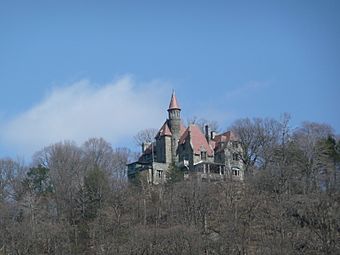Castle Rock (Garrison, New York) facts for kids
Quick facts for kids |
|
|
Castle Rock
|
|

View of castle from east, along NY 9D, 2009
|
|
| Location | Garrison, NY |
|---|---|
| Nearest city | Peekskill |
| Area | 154 acres (62 ha) |
| Built | 1881 |
| Architect | J. Morgan Slade |
| NRHP reference No. | 77000972 |
| Added to NRHP | 1977 |
Castle Rock is a large estate in Garrison, New York, USA. It was once the home of William H. Osborn, who was a president of a big railroad company. The estate sits on a hill called Castle Rock, high above the Hudson River. From the estate, you can see amazing views of the river and mountains.
Castle Rock is easy to spot from West Point across the river and from New York State Route 9D. This makes it a famous landmark in the Hudson Highlands area. The Osborn family has owned and lived in the estate since it was built in 1881. Over the years, some of the land has been sold off. In 1977, Castle Rock was added to the National Register of Historic Places. Today, much of the remaining land is open for public hiking.
Contents
What is Castle Rock Like?
The main house at Castle Rock looks like a real castle. It's built from rough-cut stone. The house has a tall, round tower with a pointy, cone-shaped roof. Many porches and verandas stick out from the house. These spots offer great views of the river and mountains.
The roof is made of red slate tiles. You can see different-shaped windows, called dormers, sticking out of the roof. One part of the house, on the east side, uses smoother stone. This is different from the rough stone used on the rest of the building. Later, a new part was added to the north side. This part included a library and more bedrooms. The house has four chimneys inside. In 2010, the roof, tower, dormers, and chimneys were all carefully repaired to keep their historic look.
Other Buildings on the Estate
There are several other buildings and structures on the original Castle Rock property. These are also important to the estate's history.
Woodsome Lodge and Water Tank
To the northeast, at the very top of the mountain, is a rustic log cabin called Woodsome Lodge. It also has great views of the Highlands. Nearby is a wooden water tank. This tank is filled by a natural spring on the property.
Bridges and Gatehouse
A stone arch bridge was built at the same time as the library wing. There is also a stone gatehouse with one and a half stories. This gatehouse is located along the winding driveway that leads up to the main house from Cat Rock Road (NY 403).
Older Farm Buildings
Some buildings on the property are even older than the main castle. One is a two-and-a-half-story farmhouse known as Wing & Wing. It was built many years before 1858, when it was made larger. This farmhouse is near Route 9D, in the open fields between the road and the hill. There's also a barn and farmhouse complex nearby. These were built by other landowners in the late 1800s. A small guest cottage was later built on a separate piece of land.
The Birches
Another property connected to the Osborn family is called The Birches. It's located at the corner of Routes 9D and 403. William Osborn's sons used this house after they got married. It is listed separately on the National Register of Historic Places.
History of Castle Rock
In 1855, William Osborn visited the Hudson Highlands. He was one of the first leaders of the Illinois Central Railroad. He loved the fresh air and beautiful scenery so much that he decided to buy the land where Castle Rock now stands.
He and his family spent their summers in the Wing and Wing farmhouse. The castle was finished in 1881, just before he retired from the railroad business. He lived at Castle Rock until he passed away in 1894. He spent his later years giving money to good causes in New York.
Henry Fairfield Osborn's Time
His son, Henry Fairfield Osborn, inherited Castle Rock. Since the castle was first built as a retirement home, it needed to be bigger for Henry's wife and family. The library wing was added in 1906. Henry Fairfield Osborn was a famous paleontologist, someone who studies fossils. Many of his important papers were written at Castle Rock.
Henry Osborn also made other improvements to the property, like building Woodsome Lodge. He added other parts to the castle, which doubled its size. These new parts matched the original design well. Not much has changed about the castle since then.
Public Land and Hiking
In 1974, William Henry Osborn II, one of Henry Fairfield's younger sons, gave the southern part of the property to the state. This part includes Sugarloaf Hill. It was meant to become part of Hudson Highlands State Park. In the late 1970s, after Castle Rock was listed on the National Register, New York's Department of Environmental Conservation bought 129 acres of the estate. This included the open fields along Route 9D. They opened this land to the public as the Castle Rock Unique Area. Now, hiking trails lead through the area and up the mountain. However, the main house property remains private.
See also
 In Spanish: Castle Rock (Garrison) para niños
In Spanish: Castle Rock (Garrison) para niños



